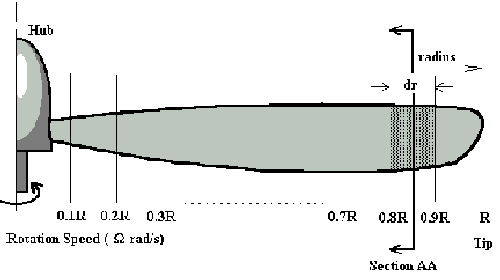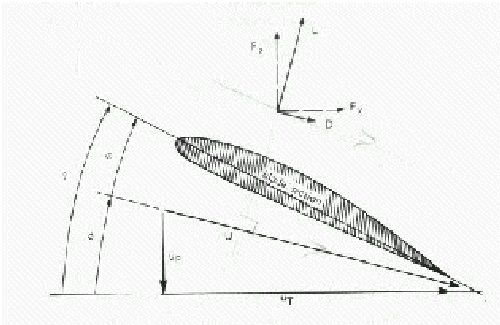Blade Element Theory (BET) is an analysis method that may be applied to a rotor,
propeller, fan, and even a lightly loaded compressor. BET is the foundation for almost all
analyses of helicopter aerodynamics because it deals with the detailed flow and loading of
the blade. The theory gives basic insights into the rotor performance as well as other
characteristics. William Froude originally conceived of BET in the 1870's.
Stefan Drzewiecki however, was the first to rigorously examine and apply BET. He performed his work between 1892 and 1920. BET is very similar to the Strip Theory for fixed wing aerodynamics. The blade is assumed to be composed of numerous, miniscule strips with width 'dr' that are connected from tip to tip.
 The lift and drag are estimated at the strip using the 2-D airfoil characteristics
of the section.
The lift and drag are estimated at the strip using the 2-D airfoil characteristics
of the section.
Also, the local flow characteristics are accounted for in terms of climb speed, inflow velocity, and angular velocity. The section lift and drag may be calculated and integrated over the blade span. BET is a very useful tool for the engineer. He or she may perform a fairly detailed local analysis of the rotor in a short amount of time.
In contrast to BET, Momentum Theory is a global analysis which gives useful results but can not be used as a stand-alone tool to design the rotor. It was originally intended to provide an analytical means for evaluating ship propellers (Rankine 1865 & Froude 1885). Later Betz (1920) extended Rankine and Froude's work to include the rotation of the slipstream. Momentum Theory is also well known as Disk Actuator Theory. Momentum Theory assumes that the flow is inviscid and steady, also the rotor is thought of as an acuator disk with an infinite number of blades, each with an infinite aspect ratio. The useful results from momentum theory that are applied to BET are listed below.

 The down wash is twice as fast as the inflow
The down wash is twice as fast as the inflow
 The ideal power is a simple function of the thrust
The ideal power is a simple function of the thrust
 If the down wash is uniform, the ideal power is minimized
If the down wash is uniform, the ideal power is minimized
 The inflow is a simple function of the thrust
The inflow is a simple function of the thrust
When the two theories are combined, it is possible to evaluate a field of induced velocity around the rotor or propeller, and therefore correct the inflow conditions assumed in the basic blade element theory. The induced velocities aren't known until the blade loads are computed. With the loading available one can re-compute the field of induced velocities. This is an iterative method, generally the quantity that is iterated for is the thrust coefficient. The combined Blade Element Momentum Theory is a fairly accurate analytical tool (for lightly loaded rotors or propellers) that can be used by the engineer early in the design of a rotor.
Stefan Drzewiecki however, was the first to rigorously examine and apply BET. He performed his work between 1892 and 1920. BET is very similar to the Strip Theory for fixed wing aerodynamics. The blade is assumed to be composed of numerous, miniscule strips with width 'dr' that are connected from tip to tip.

Also, the local flow characteristics are accounted for in terms of climb speed, inflow velocity, and angular velocity. The section lift and drag may be calculated and integrated over the blade span. BET is a very useful tool for the engineer. He or she may perform a fairly detailed local analysis of the rotor in a short amount of time.
In contrast to BET, Momentum Theory is a global analysis which gives useful results but can not be used as a stand-alone tool to design the rotor. It was originally intended to provide an analytical means for evaluating ship propellers (Rankine 1865 & Froude 1885). Later Betz (1920) extended Rankine and Froude's work to include the rotation of the slipstream. Momentum Theory is also well known as Disk Actuator Theory. Momentum Theory assumes that the flow is inviscid and steady, also the rotor is thought of as an acuator disk with an infinite number of blades, each with an infinite aspect ratio. The useful results from momentum theory that are applied to BET are listed below.

When the two theories are combined, it is possible to evaluate a field of induced velocity around the rotor or propeller, and therefore correct the inflow conditions assumed in the basic blade element theory. The induced velocities aren't known until the blade loads are computed. With the loading available one can re-compute the field of induced velocities. This is an iterative method, generally the quantity that is iterated for is the thrust coefficient. The combined Blade Element Momentum Theory is a fairly accurate analytical tool (for lightly loaded rotors or propellers) that can be used by the engineer early in the design of a rotor.
